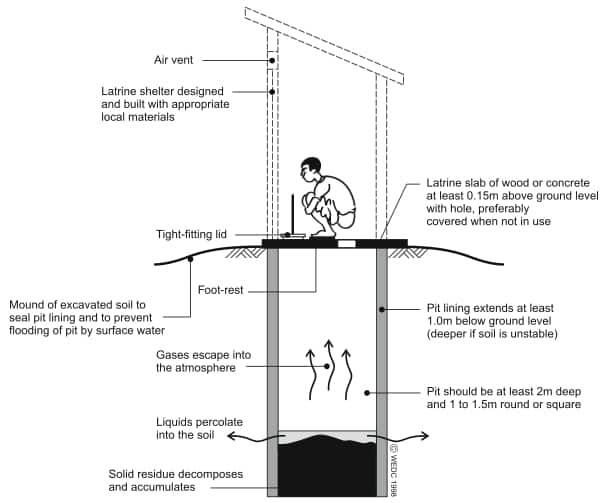What is a Pit Latrine
Pit latrines are the most common and simplest form of excreta disposal in many developing countries. These are almost universally acceptable in rural areas and are also widely used in low-income urban communities, although often not appropriate. They are, however, the cheapest system possible and the system most appropriate for individual householders responsible for their own sanitation.
A pit latrine consists of a manually dug or bored hole into the ground, an appropriate seat or squatting slab and a superstructure erected over it. The pit is simply a hole in the ground into which excreta fall. Urine and other liquids soak into the ground and solid materials are retained and decomposed in the pit.

There are many different kinds of pit latrines, all of which may not be fully sanitary and hence are not recommended. Simple pit latrines though not fully sanitary, are sometimes promoted in order to discourage open defecation and other unsanitary practices. Conventional pit latrines with a basic pit and a shielding superstructure have many disadvantages, odor and fly and mosquito nuisance in particular. For these reasons, improvements are made to make pit latrine technologies more acceptable to users.
With slight modifications in design and with little or no intervention, typical pit latrines will be improved to be healthy. There are many types of pit latrines. When excrement fall directly into a pit beneath the user, it’s referred to as a direct pit latrine. When excreta goes through pipe or a channel to a pit a couple of meters away, it is called an offset pit latrine. It may be called a partly offset pit latrine when part of the pit is under the shelter and part is outside, where a removable cover allows the contents to be taken out. The most appropriate type of pit latrine depends on the local situation, particularly on the type of materials used for anal cleansing including the level of the groundwater and the traditions and the choice of the users.
The advantages and disadvantages of pit latrines are discussed below.
Advantages of Pit Latrine
The advantages of pit latrines include the followings:
- Pit latrines are least costly;
- these are easily constructed and maintained;
- structurally safe and therefore free from the risk of children falling into it and thus less frightening for children;
- prevents hookworm transmission;
- offers a better solution than open defecation and unhygienic hanging latrines.
Disadvantages of Pit Latrine
The serious disadvantages of pit latrines are:
- flies lay their eggs in faeces within poorly built latrines. An increase in the fly population increases the spread of diseases caused by the faecal pathogens they carry;
- odor nuisance;
- the improper lining of pits may lead to the collapse of the superstructure.
